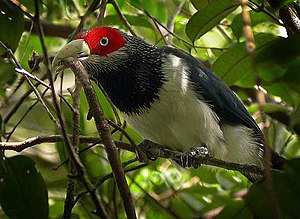Red Face Malkoha
| Red Face Malkoha | ||||||||||||
|---|---|---|---|---|---|---|---|---|---|---|---|---|

Red-faced Malkoha ( Phaenicophaeus pyrrhocephalus ) |
||||||||||||
| Systematics | ||||||||||||
|
||||||||||||
| Scientific name | ||||||||||||
| Phaenicophaeus pyrrhocephalus | ||||||||||||
| ( Pennant , 1769) |
The red-faced malkoha ( Phaenicophaeus pyrrhocephalus ) or naked-forehead cuckoo belongs to the cuckoo family (Cuculidae). It is endemic to Sri Lanka and is a resident bird. Unlike many cuckoos, it is not an obligatory brood parasite , but rather raises its offspring itself.
The red-faced malkoha lives in dense forests, which are increasingly declining in Sri Lanka. Accordingly, the population of this cuckoo species has been declining for a long time and the IUCN considers it possible that the global population is only a few hundred individuals. The stock situation is indicated accordingly with "vu" ( vulnerable - endangered).
description
The red-faced Malkoha reaches a body length of 40 to 46 cm. The tail accounts for around 29 centimeters. There is no very noticeable gender dimorphism , but the sexes can be differentiated by the color of the iris. Males have a brown iris while females have a whitish one.
Red-faced Malkohas have large, light apple-green beaks. The face appears naked, but is made up of short, hair-like and bright red feathers. They contrast with a white stripe on the cheeks and a black skull. The nape and the sides of the neck are also black with individually varying degrees of white speckles. The chin is white, but the throat and front chest are black. The rest of the breast as well as the flanks, the belly and the under tail-covers are white. The top of the body and the wings are black with a greenish or bluish tinge. The upper tail covers are outlined in dark green and white. The tail is long, tiered and ends with a wide white band. the feet are gray-blue or bluish green.
Fledglings are similar to the adult birds, but the red plumage on the face is even less pronounced, the adult bird has black plumage, they are brownish and the tail feathers are shorter.
distribution and habitat
The red-faced malkoha is a resident of Sri Lanka. There are a few observations of this species from the Indian states of Kerala and Tamil Nadu, which Erhitzøe has classified as dubious . He's probably just a stray there.
The habitat of the red-faced malkoha are dense, tall and humid primary forests with dense undergrowth. It is rarely seen in secondary forests or near cultivated land. Its altitude range extends up to 1700 meters, but observations above 920 meters are rare and all of them are older. Erhitzøe therefore considers it possible that, due to the fragmentation of the forests that represent its habitat, the red-faced Malkoha can only be found in the lower regions of Sri Lanka.
Way of life

The way of life of the red-faced alcoholic has not yet been conclusively investigated. The period and duration of the breeding season is unclear. However, evidence indicates that the breeding season falls in the period January to May and there may be a second breeding period in the months of August to September.
The nests found so far were high in trees, the nest platform was a dense underlay of 15 to 20 centimeters long branches. The nest is cup-shaped and lined with leaves. The clutch consists of two to three chalk-white eggs. Both parent birds are involved in raising the nestlings.
The red-faced malkoha probably lives mainly on insects, fruits and berries have also been proven as part of its diet.
Danger
The red-faced malkoha used to be common from southern India to Sri Lanka. Above all, the destruction of the forests has displaced it to a few protected areas in the south of Sri Lanka. The main threats are gem mining, slash and burn, felling of firewood and the conversion of forest areas into arable land or plantations. As a species that also relies on a tightly closed treetop area, it reacts very sensitively to the selective cutting of individual large trees. The main area of distribution today is the Sinharaja World Heritage Reserve with a size of 11,187 hectares. The increasing fragmentation of the habitat can lead to increasing inbreeding.
Its holdings are estimated at 2,500 to 10,000 copies. Despite protective measures, the population has decreased, so that it is classified as vulnerable (endangered) by the IUCN.
literature
- Johannes Erhitzøe, Clive F. Mann, Frederik P. Brammer, Richard A. Fuller: Cuckoos of the World . Christopher Helm, London 2012, ISBN 978-0-7136-6034-0 .
Web links
- Phaenicophaeus pyrrhocephalus in the endangered Red List species the IUCN 2008. Posted by: BirdLife International, 2008. Accessed August 28, 2016th
- Photos of this kind at the Oriental Bird Club
- ARKive - images and information about the Red-Faced Malkoha (Engl.)
Single receipts
- ↑ a b Phaenicophaeus pyrrhocephalus in the endangered Red List species the IUCN 2008. Posted by: BirdLife International, 2008. Accessed August 28, 2016th
- ↑ a b c d e f g h Erhitzøe, Mann, Brammer, Fuller: Cuckoos of the World . P. 242.
- ↑ a b c Erhitzøe, Mann, Brammer, Fuller: Cuckoos of the World . P. 243.
